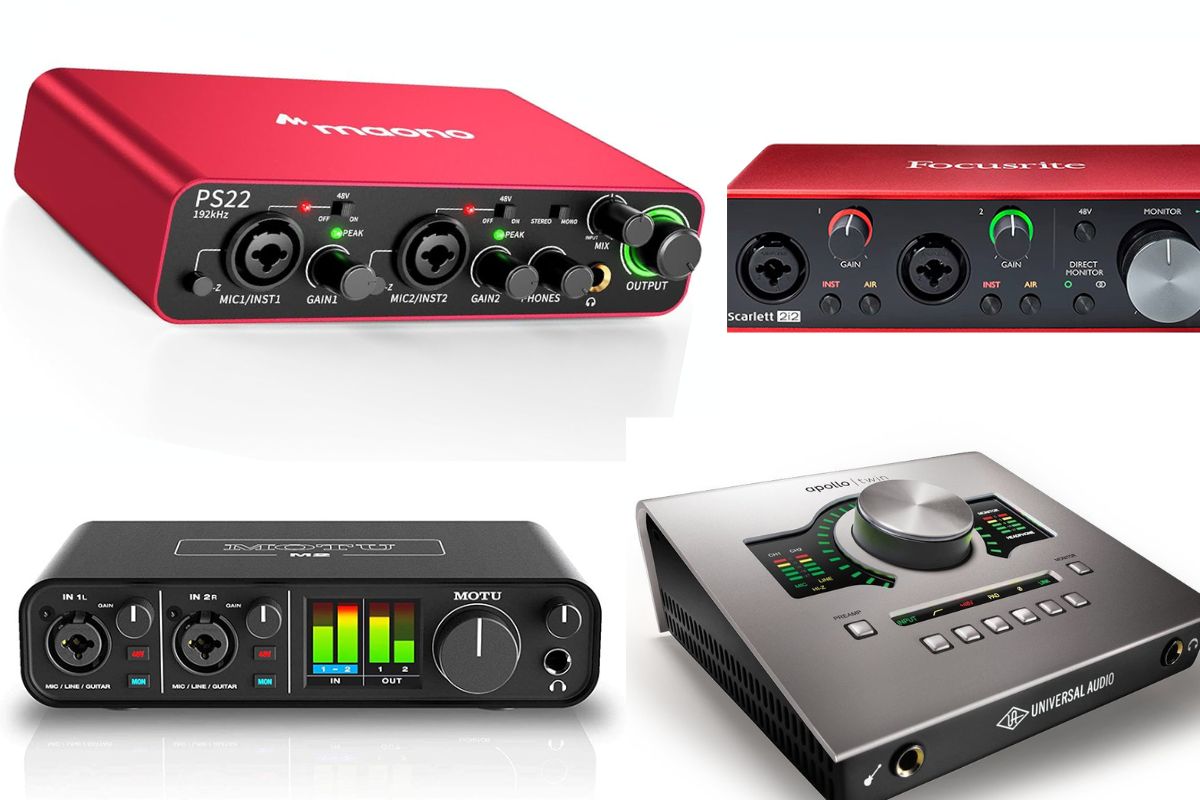Best audio interfaces for music production with mixer has evolved tremendously over the past few decades, with technology providing greater convenience, flexibility, and creativity. One essential piece of modern producers’ equipment is the audio interface, particularly those integrated with a mixer. These versatile tools are a boon for anyone looking to enhance their recording, mixing, or live performance experience. Whether you’re a beginner, an intermediate producer, or a seasoned professional, there’s something for everyone in this comprehensive guide.
What is an Audio Interface?
The hardware that links your computer to your instruments, microphones, and other audio equipment is called an audio interface. It converts analogue signals into digital audio that your computer can process, allowing you to record, edit, and mix music in a digital audio workstation (DAW). Simply put, it bridges the gap between your hardware and software, ensuring your sound reaches the DAW in high fidelity.
Why Choose an Audio Interface with a Mixer?
Choosing an audio interface with a mixer provides unparalleled control. While a standalone interface offers connectivity and signal conversion, an integrated mixer adds flexibility to balance sound levels, add effects, and control different real-time input channels. This combination is particularly useful for live recordings, podcasting, or complex studio setups where you need more immediate control over multiple sound sources.
Benefits of Audio Interfaces with Integrated Mixers for Music Production
- Real-Time Control: Adjust sound levels, EQ, and effects during recording without going through software settings.
- Versatility: Ideal for both studio use and live performances, offering quick adjustments to improve sound quality on the spot.
- Streamlined Workflow: Having both an interface and mixer in one device reduces the clutter and complexity in your setup.
- Improved Monitoring: Many mixer interfaces provide multiple monitoring outputs, allowing for seamless headphone mixes and speaker connections.
How to Choose the Best Audio Interface for Music Production
Selecting the right audio interface with a mixer is critical for optimizing your workflow and achieving the best sound quality. Here’s what to keep in mind:
Key Features to Consider
Channel Count
The number of inputs and outputs the audio interface offers is called the channel count. A higher channel count (eight or more) will be necessary if multiple instruments are recorded simultaneously. Fewer channels may suffice for simpler setups, such as solo artists or podcasters.
Audio Quality (Bit Depth and Sample Rate)
For professional-grade audio, focus on interfaces that support at least 24-bit depth and a sample rate 96kHz or higher. These specs ensure high-fidelity sound and more precise editing capabilities, which are important when capturing intricate performances or producing high-quality music.
Connectivity (USB, Thunderbolt, etc.)
Choosing between USB and Thunderbolt interfaces depends on your system’s connectivity and performance needs. Thunderbolt interfaces offer faster data transfer, making them ideal for professional studio setups where low latency is essential. USB interfaces, while slower, are more common and can still offer excellent performance.
Compatibility with DAWs
Ensure that the audio interface is fully compatible with your DAW of choice. Some interfaces come with specific software that integrates seamlessly with certain DAWs, offering enhanced control and workflow improvements.
Latency Performance
Latency is the delay between when a sound is generated and when you hear it. Low-latency performance is crucial for real-time monitoring and recording, as high latency can disrupt production. Opt for interfaces with ultra-low latency specs.
Budget Considerations
Your budget will significantly impact the features and overall quality of the interface you choose. However, there are excellent options at every price point—from budget-friendly models for home studios to high-end units for professional studios.
Portability vs. Studio Use
Consider your environment—a compact and portable interface with a built-in mixer is ideal if you’re often on the go. On the other hand, larger, more robust interfaces may be better suited for permanent studio setups.
Mixer Functions You Should Look For
When choosing an audio interface with a mixer, look for key features such as preamps, EQ controls, built-in effects, and multiple input/output options. These features allow you to adjust your sound both during and after recording.
The 20 Best Audio Interfaces for Music Production with Mixer
Now that we’ve covered the key considerations, here’s a breakdown of the top 20 best audio interface for music production with mixer in 2024, ranked by performance, features, and suitability for various production environments.
Focusrite Scarlett 18i8 3rd Gen
Overview and Key Features: A popular choice for home studios, the Scarlett 18i8 offers excellent preamps, 18 inputs, and eight outputs, ensuring versatility for multiple instruments and microphones. The Scarlett series is known for its reliability and sound quality.
Pros and Cons for Music Producers: Pros include easy setup, great build quality, and excellent sound reproduction. However, it may lack advanced features for high-end studios.
Best Suited For: Home studios that need a balance of performance and affordability.
PreSonus StudioLive AR12c
Overview and Key Features: This interface offers digital and analogue functionality, perfect for live streaming or studio recording. It features a 14-channel mixer, built-in effects, and multitrack recording.
Pros and Cons for Music Producers: The versatile mixer and built-in effects are excellent for live recording, but the price point may be too high for some beginners.
Best Suited For: Recording and live streaming.
Behringer Xenyx QX1204USB
Overview and Key Features: A budget-friendly option that doesn’t skimp on features. It offers a 12-input mixer with four preamps and built-in effects. Despite the low price, it delivers impressive sound quality.
Pros and Cons for Music Producers: Very affordable, but the construction quality isn’t as robust as higher-end models.
Best Suited For: Budget-conscious producers.
Universal Audio Apollo Twin X
Overview and Key Features: Known for its pristine sound quality, the Apollo Twin X offers Unison preamps, which emulate vintage hardware, and Thunderbolt connectivity for ultra-low latency. The built-in UAD plugins are a significant bonus.
Pros and Cons for Music Producers: It has excellent sound and low latency, but it’s one of the more expensive options on the market.
Best Suited For: High-end studio production.
Yamaha AG06 MK2
Overview and Key Features: This compact interface is perfect for small studios or podcasting. It includes two mic/line inputs, a loopback function, and built-in effects, making it versatile and easy to use.
Pros and Cons for Music Producers: It’s great for small setups but limited in terms of inputs and outputs for larger productions.
Best Suited For: Podcasting and small studios.
Zoom LiveTrak L-8
Overview and Key Features: This interface offers eight inputs and 10 channels, and it doubles as a portable recorder, making it ideal for studio and live performances. It also features built-in effects and headphone outputs for multiple users.
Pros and Cons for Music Producers: Extremely versatile and portable, but may lack some high-end studio features.
Best Suited For: Multi-purpose use in both studio and live environments.
Mackie ProFX12v3
Overview and Key Features: With 12 channels, the ProFX12v3 is designed for flexible music production. It features built-in effects, USB recording, and Mackie’s signature low-noise preamps.
Pros and Cons for Music Producers: The sound quality is great, but the build quality could be improved for professional use.
Best Suited For: Versatile music production.
Tascam Model 12
Overview and Key Features: A hybrid mixer that integrates analogue and digital workflows. It offers 12 channels, built-in effects, and multitrack recording capabilities. The retro design is a plus for those who appreciate tactile controls.
Pros and Cons for Music Producers: This is a fantastic hybrid option, but the price may be high for beginners.
Best Suited For: Hybrid recording setups.
M-Audio AIR 192|14
Overview and Key Features: A solid entry-level interface with eight inputs, four outputs, and excellent sound quality for its price. It’s also compact and easy to use.
Pros and Cons for Music Producers: It is affordable and straightforward, but it may lack advanced features for more experienced producers.
Best Suited For: Beginner to intermediate producers.
Allen & Heath ZEDi-10
Overview and Key Features: This mixer combines analog warmth with digital convenience. It has four mic/line inputs, integrated effects, and USB connectivity for smooth DAW integration.
Pros and Cons for Music Producers: Offers great flexibility but may be limited to large-scale productions.
Best Suited For: Flexible recording and mixing.
Roland GO
Overview and Key Features: Designed with mobile producers in mind, the GO
offers a compact design with multiple inputs and Bluetooth streaming capability. It’s ideal for on-the-go music creation.
Pros and Cons for Music Producers: Extremely portable, but lacks the depth of features found in larger interfaces.
Best Suited For: Mobile music production.
Soundcraft Notepad-12FX
Overview and Key Features: A compact mixer with excellent sound quality and built-in Lexicon effects. It’s ideal for small studios and podcasting.
Pros and Cons for Music Producers: It is affordable and easy to use but may not have enough input for more complex setups.
Best Suited For: Small studios or podcasting.
Native Instruments Komplete Audio 6 MK2
Overview and Key Features: This compact, high-quality audio interface offers 6 channels and low-latency performance. It’s perfect for electronic music producers using Native Instruments software.
Pros and Cons for Music Producers: Seamless integration with Native Instruments software lacks advanced mixer features.
Best Suited For: Electronic music producers.
SSL 2+ Audio Interface
Overview and Key Features: Solid State Logic (SSL) is known for its high-end studio equipment, and the SSL 2+ is no exception. It offers two inputs: ultra-low latency and pristine sound quality.
Pros and Cons for Music Producers: Excellent sound, but limited inputs for large-scale productions.
Best Suited For: High-quality home studio recordings.
Audient EVO 8
Overview and Key Features: This compact interface offers smart gain control, making it ideal for beginners who want great sound without the complexity. It offers 4 inputs and 4 outputs, perfect for smaller projects.
Pros and Cons for Music Producers: User-friendly but unsuitable for larger setups.
Best Suited For: Beginner to intermediate producers.
Steinberg UR44C
Overview and Key Features: This interface offers 4 mic/line inputs and excellent integration with Cubase. It provides robust sound quality and low latency for an affordable price.
Pros and Cons for Music Producers: Seamless Cubase integration but limited mixer functionality.
Best Suited For: Producers using Cubase.
Alesis MultiMix 4 USB FX
Overview and Key Features: A simple yet effective mixer with 4 channels and built-in effects. It’s ideal for beginners or podcasters who need basic mixing functionality.
Pros and Cons for Music Producers: Affordable but limited in inputs and outputs.
Best Suited For: Beginners and podcasters.
Focusrite Clarett+ 8Pre
Overview and Key Features: This high-end interface offers eight inputs, 10 outputs, and ultra-low latency. It’s designed for professional studios that demand pristine sound quality and flexibility.
Pros and Cons for Music Producers: Excellent performance, but comes with a high price tag.
Best Suited For: Professional Studios.
Arturia AudioFuse Studio
Overview and Key Features: A high-end interface that offers 8 preamps, built-in effects, and a robust feature set. It’s ideal for professional producers looking for top-notch sound quality and flexibility.
Pros and Cons for Music Producers: High-quality sound and features, but may be overkill for home studios.
Best Suited For: Professional music production.
MOTU 828es
Overview and Key Features: Offering 28 inputs and 32 outputs, the MOTU 828es is a powerhouse interface for large-scale productions. It features built-in DSP effects and ultra-low latency performance.
Pros and Cons for Music Producers: It offers amazing flexibility and sound quality, but the high price makes it more suitable for established studios.
Best Suited For: Large-scale and professional studio setups.
Conclusion
Whether you’re just starting your music production journey or looking to upgrade your studio setup, selecting the right audio interface with a mixer can dramatically improve your workflow and sound quality. From budget-friendly options like the Behringer Xenyx QX1204USB to high-end professional models like the MOTU 828es, there’s a perfect fit for every producer’s needs. When choosing your interface, consider your specific recording requirements, the number of inputs/outputs needed, and your desired audio quality. You’ll elevate your music production game and streamline your entire process with the right choice.
Frequently Asked Questions (FAQs)
What distinguishes a mixer from an audio interface?
An audio interface converts analogue signals to digital for your computer, while a mixer allows for real-time control over levels, effects, and EQs for multiple channels.
Do I need an audio interface with a mixer for home recording?
While not essential, an audio interface with a mixer provides greater control over multiple inputs and can streamline the recording process.
Can I use an audio interface with a mixer for live performances?
Yes, many audio interfaces with mixers are designed for studio use and live performances, offering real-time sound control.
Are USB or Thunderbolt audio interfaces better?
Thunderbolt interfaces provide faster data transfer and lower latency, making them ideal for professional setups. However, USB interfaces are more common and often more affordable.
What should I look for in an audio interface for music production?
Key features include the number of inputs/outputs, audio quality, low latency, DAW compatibility, and any built-in effects or mixer functionality.





















